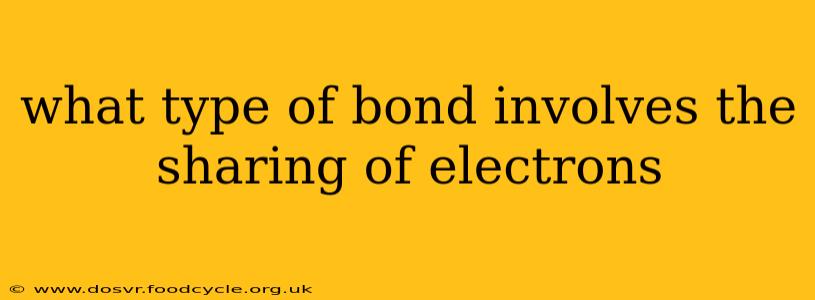A covalent bond involves the sharing of electrons between atoms. This sharing creates a strong attraction that holds the atoms together, forming a molecule. Understanding covalent bonds is fundamental to grasping the behavior of many compounds and materials in the world around us. Let's delve deeper into this crucial concept in chemistry.
What are the Characteristics of a Covalent Bond?
Covalent bonds are primarily formed between nonmetal atoms. These atoms have a relatively high electronegativity, meaning they strongly attract electrons. Instead of one atom completely transferring electrons to another (as in ionic bonds), atoms involved in a covalent bond share one or more pairs of electrons. This shared electron pair is attracted to the nuclei of both atoms, creating the bond.
The strength of a covalent bond depends on several factors including the number of shared electron pairs and the distance between the atoms. The more electron pairs shared, the stronger the bond.
How Many Electrons are Shared in a Covalent Bond?
The number of shared electrons can vary. A single covalent bond involves the sharing of one electron pair (two electrons). A double covalent bond involves the sharing of two electron pairs (four electrons), and a triple covalent bond involves the sharing of three electron pairs (six electrons). The type of bond dictates the properties of the resulting molecule. For example, a triple bond is significantly stronger than a single bond.
What are Some Examples of Covalent Bonds?
Covalent bonds are extremely common. Here are a few examples:
- Water (H₂O): Oxygen atoms share electrons with two hydrogen atoms, forming two single covalent bonds.
- Oxygen gas (O₂): Two oxygen atoms share two pairs of electrons, forming a double covalent bond.
- Nitrogen gas (N₂): Two nitrogen atoms share three pairs of electrons, forming a strong triple covalent bond.
- Methane (CH₄): A carbon atom shares single covalent bonds with four hydrogen atoms.
- Carbon Dioxide (CO₂): A carbon atom shares double covalent bonds with two oxygen atoms.
What is the Difference Between Covalent and Ionic Bonds?
It's crucial to distinguish covalent bonds from ionic bonds. While covalent bonds involve sharing electrons, ionic bonds involve the transfer of electrons from one atom to another. This transfer creates ions – charged atoms – which are held together by electrostatic attraction. Ionic bonds typically form between metals and nonmetals, whereas covalent bonds are formed between nonmetals.
What are Polar and Nonpolar Covalent Bonds?
Not all electrons are shared equally in a covalent bond. In a nonpolar covalent bond, the electrons are shared almost equally between the atoms, resulting in a relatively symmetrical distribution of charge. This usually occurs when atoms of the same element are bonded (e.g., O₂).
In a polar covalent bond, the electrons are shared unequally. One atom attracts the shared electrons more strongly than the other, creating a slightly negative charge (δ-) on the more electronegative atom and a slightly positive charge (δ+) on the less electronegative atom. This creates a dipole moment – a separation of charge within the molecule. Water is a classic example of a molecule with polar covalent bonds.
How Do Covalent Bonds Affect the Properties of Substances?
The type and strength of covalent bonds significantly impact the properties of substances. For instance, substances with strong covalent bonds often have high melting and boiling points, while those with weaker covalent bonds have lower melting and boiling points. The presence of polar covalent bonds can lead to properties such as solubility in polar solvents (like water) and high surface tension.
Understanding covalent bonds is fundamental to understanding the structure and behavior of a vast array of molecules, from simple gases to complex biological macromolecules. The sharing of electrons provides the foundation for the immense diversity of compounds we observe in the natural world.
